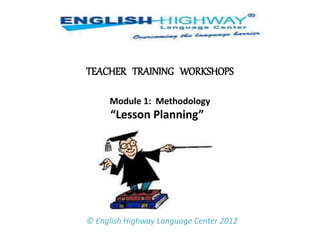
lessonplaning-phpapp02.ppt
- 1. TEACHER TRAINING WORKSHOPS Module 1: Methodology “Lesson Planning” © English Highway Language Center 2012
- 2. Principles of Communicative Teaching
- 3. TASK 1: Answer the following questions and discuss your answers with your peer 1. Why is lesson planning important? 2. How is lesson planning important for the teacher? for the learners? 3. What do you take into account when you design a lesson plan? 4. What constant components are there in your lesson plan?
- 4. 1. Why is lesson planning important? Being clear on what you want to teach Being ready to cope with whatever happens Give your teaching a framework, an overall shape A reminder for the teacher when they get distracted It suggests a level of professionalism and real commitment.
- 5. 2. How is lesson planning important for the teacher and the learner? Teachers They don’t have to think on their feet. They don’t lose face in front of their learners. They are clear on the procedure to follow. They build on previous teaching and prepare for coming lessons Learners They realize that the teacher cares for their learning. They attend a structured lesson: easier to assimilate They appreciate their teacher’s work as a model of well-organized work to imitate.
- 6. 3. What do you take into account when you design a lesson plan? Balance Flexibility Variety Challenge Coherence
- 7. Variety Why vary? to meet different learning styles to consider different intelligence types to keep learners interested and avoid monotony What to vary? Contents Activities Interaction modes Materials Aids …
- 8. Ways of Varying these different components 1. Tempo/Pace : Activities may be brisk and fast-moving, such as guessing games; or slow and reflective, such as reading or responding in writing. 2. Mode : The learners may work on their own at individualized tasks, or in pairs or groups, or as a full class in interaction with the teacher. 3. Mode and Skill : Activities may be based on the written or the spoken language; and within these, they may vary as to whether the learners are asked to produce (speak/ write) or receive (listen / read ).
- 9. 4. Difficulty : Activities may be seen as easy and non demanding; or difficult , requiring concentration and effort. 5. Mood : Activities vary also in mood: light and fun -based versus serious and profound; happy versus sad; tense versus relaxed. 5. Stir - Settle : Some activities enliven and excite learners ( such as controversial discussions for advanced levels), or activities which involve physical movement (such as the race dictation) for the lower levels. Others, like dictation, have the effect of calming them down 6. Active - Passive : Learners may be activated in a way that encourages their own initiative ; or they may only be required to do as they are told
- 10. COHERENCE Observe a logical pattern to the lesson: there has to be connection between the different activities in the lesson Smooth transition is one of the pillars that ensures success of the lesson plan during implementation in the classroom An activity in a lesson builds on a previous one and prepares for the next
- 11. Challenge Learners are intelligent human beings and come to class with knowledge previously acquired. The new lesson should add to that knowledge without excess. The lesson that does not challenge is a lesson that does not motivate. No learning happens if the lesson doesn’t present new items beyond students’ prior knowledge.
- 12. Flexibility Two dimensions: ability to use a number of different techniques and not be a slave to one methodology– Principled eclecticism. ability to change the plan if it shows inappropriacy to the classroom real situation for a reason or another.
- 13. Balance The lesson is a mixture of a number of ingredients: techniques, activities and contents. The successful teacher is the one who is able to observe the right dosage and make the learners enjoy a savoury lesson.
- 14. What do you take into account? Objectives set out to be achieved Prior knowledge of learners Materials and didactic auxiliaries to be used Tasks and activities to select and students’grouping patterns Interaction modes Timing and time management
- 15. COMPONENTS OF A LESSON PLAN LEARNERS:
- 18. Continued … AIDS